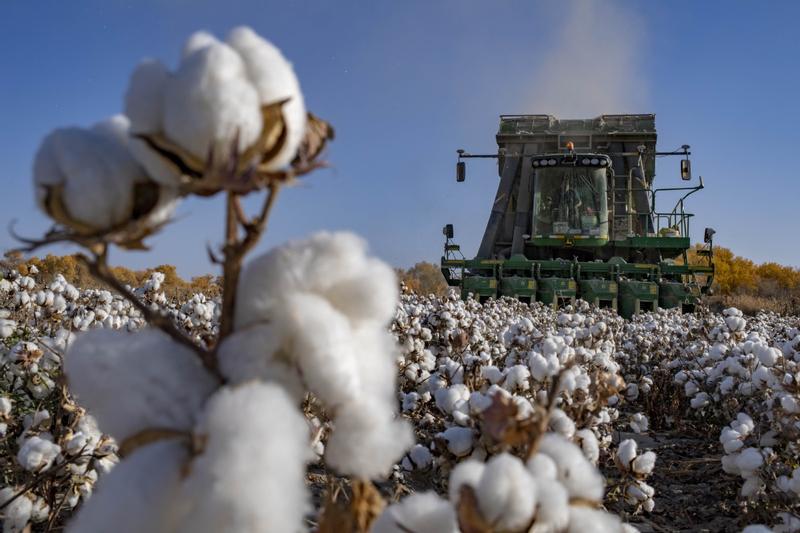 A harvesting machine picks cotton in a field in Shaya county, Aksu, Xinjiang Uygur autonomous region, in October. (PHOTO / XINHUA)
A harvesting machine picks cotton in a field in Shaya county, Aksu, Xinjiang Uygur autonomous region, in October. (PHOTO / XINHUA)
The boycott of cotton sourced from Northwest China's Xinjiang Uygur autonomous region is set to disrupt normal global supply cooperation, which will severely harm the global industrial and supply chain, especially as the world economy has not yet recovered from the impact of the COVID-19 pandemic, industry experts said on Friday.
Official data showed China produced around 5.95 million metric tons of cotton during the 2020-21 season
They said global supply chain curbs on Xinjiang cotton are interfering with the normal operation of the global industrial and trading market, and will harm not only the global textile industrial system but also the interests of global consumers.
The comments came as the Chinese public voiced outrage upon finding out that several big global retail giants, including H&M and Nike, have chosen not to source cotton from the region over claims of "forced labor" based on lies and false information.
ALSO READ: Xinjiang denounces sanctions as utterly groundless
The Chinese public's support for Xinjiang cotton led shares of cotton companies traded in Shanghai and Shenzhen to rise 2.33 percent on Friday, according to Shanghai-based information provider Wind Info.
Shares of Chinese domestic sportswear groups also surged on Friday. On the Hong Kong Stock Exchange, Li Ning jumped nearly 3 percent, while Anta surged over 5 percent and Xtep increased nearly 3 percent.
However, ICE cotton futures fell on Thursday to their lowest level in more than three months amid market concerns over the boycott.
Mei Xinyu, a researcher at the Chinese Academy of International Trade and Economic Cooperation, said the boycott is interfering with the normal order of the industry and the market, which will increase costs and severely impact the global market.
However, Mei said global supply chain curbs on Xinjiang cotton will not hinder China's long-term development due to a hiatus between demand and supply.
Official data showed China produced around 5.95 million metric tons of cotton during the 2020-21 season, while its total demand reached 7.8 million tons during the same period.
"The impact of the boycott will propel China to focus on weak links in the related industries, which is conducive to fostering sustainable development and ensuring economic and social stability for the long run."
Yang Shu, associate professor at China Agricultural University, said the boycott of Xinjiang cotton was a game involving political and economic interests.
"Xinjiang cotton is not a regional product but is deeply embedded in the international trade system."
Yang said the boycott will affect the development of both China's textile industry and international trade, and it will also impact employment in Xinjiang.
"Facing the complicated international situation, Chinese cotton farmers and related enterprises should protect their rights through legal means. And the country needs to make every effort to have a far greater say in the cotton textile industry, and strive to participate in the formulation of standards and pricing. More efforts should also be made to diversify the layout of the industrial chain, improve the ability to defend against risks, boost innovation and further improve product quality," Yang added.
China is the world's second-largest cotton producer, and Xinjiang is the largest cotton-producing area in the country. Xinjiang manufactured 5.2 million metric tons of cotton during the 2020-21 season-about 87 percent of the nation's total production, data from China Grain Reserves Group showed.
As of the end of 2019, Xinjiang had 808 cotton processing enterprises, accounting for 84 percent of the country's total, according to the China National Textile and Apparel Council.
"In fact, the world is in need of Chinese textile and apparels products, as global consumers enjoy quality and affordable textile and apparel products from China," said Liu Jie, a senior cotton market analyst at Sublime China Information.
READ MORE: Boycott of Xinjiang cotton use opposed
Data from the General Administration of Customs showed China's textile and apparel exports increased 9.5 percent year-on-year to US$291.22 billion last year, making it the world's largest textile and apparel exporter. Those products are mainly exported to the European Union, the United States and Southeast Asia.
Liu took a rosy view of Xinjiang cotton's future development, saying that China needs to pay close attention to the global market's situation and should strive to gain more pricing power in the cotton market.


